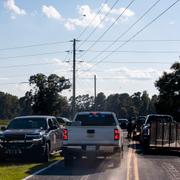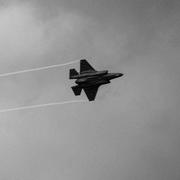
Planet fortsatt försvunnet – men är inte i luften
Det försvunna pilotlösa F-35-stridsflygplanet är fortfarande inte återfunnet men myndigheterna är nu ”säkra” på att det inte är i luften, rapporterar NBC News.
Tidigare på måndagen meddelade det amerikanska försvaret att en pilot skjutit ut sig med raketstol när planet flög på autopilot, vilket innebar att planet kan ha flugit förarlöst.
Flygplanets transponder har slutat fungera och man har därför inte kunnat hitta flygplanet. Sökuppdraget försvåras ytterligare av att F-35 har en god förmåga att undvika radar.
– Sökuppdraget fortsätter och vi är tacksamma för den hjälp vi får, säger Joe Leitner, talesperson för 2nd Marine Aircraft Wing enligt NBC.
Flygplanets senaste kända plats var i närheten av en flygbas i South Carolina.
bakgrund
Lockheed Martin F-35 Lightning II
Wikipedia (en)
The Lockheed Martin F-35 Lightning II is an American family of single-seat, single-engine, all-weather stealth multirole combat aircraft that is intended to perform both air superiority and strike missions. It is also able to provide electronic warfare and intelligence, surveillance, and reconnaissance capabilities. Lockheed Martin is the prime F-35 contractor, with principal partners Northrop Grumman and BAE Systems. The aircraft has three main variants: the conventional takeoff and landing (CTOL) F-35A, the short take-off and vertical-landing (STOVL) F-35B, and the carrier-based (CV/CATOBAR) F-35C.
The aircraft descends from the Lockheed Martin X-35, which in 2001 beat the Boeing X-32 to win the Joint Strike Fighter (JSF) program. Its development is principally funded by the United States, with additional funding from program partner countries from the North Atlantic Treaty Organization (NATO) and close U.S. allies, including the United Kingdom, Australia, Canada, Italy, Norway, Denmark, the Netherlands, and formerly Turkey. Several other countries have also ordered, or are considering ordering, the aircraft. The program has drawn much scrutiny and criticism for its unprecedented size, complexity, ballooning costs, and much-delayed deliveries. The acquisition strategy of concurrent production of the aircraft while it was still in development and testing led to expensive design changes and retrofits.The F-35 first flew in 2006 and entered service with the U.S. Marine Corps F-35B in July 2015, followed by the U.S. Air Force F-35A in August 2016 and the U.S. Navy F-35C in February 2019. The aircraft was first used in combat in 2018 by the Israeli Air Force. The U.S. plans to buy 2,456 F-35s through 2044, which will represent the bulk of the crewed tactical aviation of the U.S. Air Force, Navy, and Marine Corps for several decades; the aircraft is planned to be a cornerstone of NATO and U.S.-allied air power and to operate until 2070.
Omni är politiskt obundna och oberoende. Vi strävar efter att ge fler perspektiv på nyheterna. Har du frågor eller synpunkter kring vår rapportering? Kontakta redaktionen


